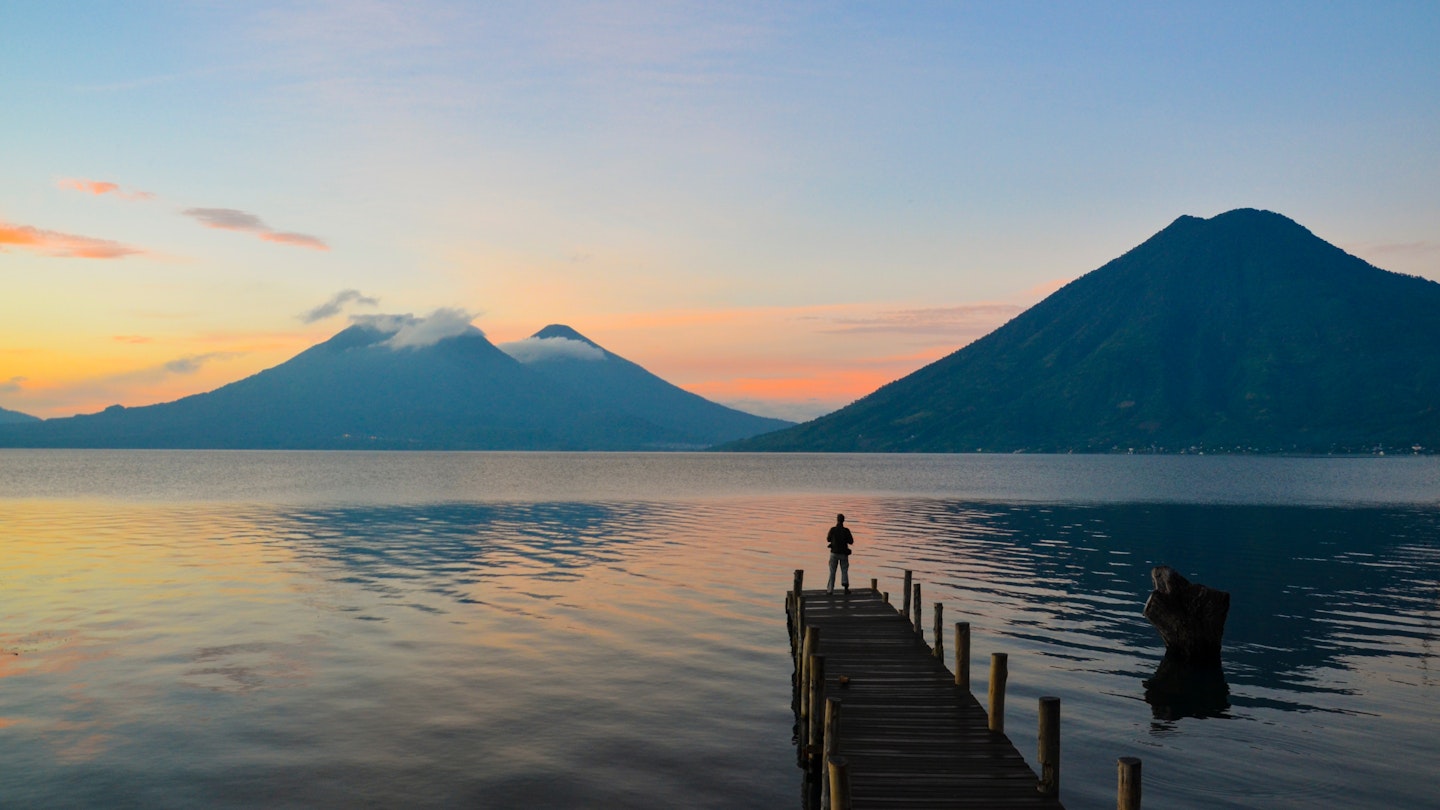Guatemala may be called the Land of Eternal Spring, but that doesn’t mean the weather is always spring-like all year round. While temperatures generally vary according to altitude rather than by time of year, the country has two distinct seasons that can have a big effect on the experience of traveling in this colorful corner of Central America.
The year can be roughly divided into the rainy season and dry season, but these could also be described as the "muddy" and "dusty" seasons. The weather dictates the high season for tourism, and the rains can have a big effect on how you enjoy different sights and activities.
This doesn’t mean there’s a bad time to visit, but you might have to adapt your expectations according to the timing of your visit, particularly if you want to enjoy the beach or go trekking in the rainforest.
Here's our guide to the best times to visit Guatemala.
The winter high season (November–March) is the best time for festivals and dry weather
Guatemala doesn’t have a traditional high season, shoulder season and low season. Instead, there are two high seasons separated by two low seasons.
The first high season coincides with Guatemala’s dry season, so sunny days are pretty much guaranteed. The dry weather kicks off at the beginning of November, when the hurricane season draws to a close, just in time for the Day of the Dead celebrations. This first high season typically ends just after Holy Week (Semana Santa) in the run-up to Easter – another of Guatemala's biggest festivals – normally in late March or the first half of April.
Many tourist stops get busy as Guatemalan city-dwellers take time off for Christmas and New Year, but the peak tourist season is Holy Week. This is the most important religious holiday for Guatemalans and it's also when they have their main annual vacation. During Holy Week, locals flock to the coast and Lake Atitlán, which means big crowds in these destinations.
The historic former capital, Antigua, also gets busy for Holy Week, when crowds gather to watch its famously colorful religious processions. Budget for higher prices and book your accommodations ahead of time during the high season (this is essential during Holy Week). If you want to avoid the crowds, Guatemala City is less frenetic than usual during this time.
If you visit between November and March, keep in mind that nighttime temperatures can drop quite drastically in the highlands, falling to near freezing in Quetzaltenango. You won’t need a heavy winter coat unless you’re planning on camping, but a warm jacket and socks are essential.
Along with dusty and windy conditions, there may be lots of smoke in the air, as this is the season when farmers burn off the old vegetation in their fields in preparation for the next planting season. If you’re prone to allergies or respiratory ailments, remember your medication and consider wearing a face mask.

The summer high season (June–August) is the best time for outdoor pursuits and Spanish lessons
The second high season coincides with the summer vacation season in the United States, Canada and Europe. It’s not quite as busy as during the first high season, but it’s definitely not the time for escaping the crowds either. June is still firmly in the rainy season, but it's usually hot and sunny in the morning and the rain usually arrives in the late afternoon or evening.
For a few weeks in July and August – the exact period varies from year to year – there is a short dry period known as the canícula. It gets very hot, and there is no relief in the form of afternoon showers. However, because the skies are clear, it’s a great time to hike to lookouts and volcano summits, visit Mayan ruins in the Petén jungle, and float down the river at Semuc Champey.
Many students take advantage of this second high season to study Spanish at one of Guatemala’s many language schools during summer break. Having lots of other students studying at the same time means there's more opportunity to swap notes, and you won't feel like the only foreigner in town.
The summer months are also the best time to enjoy the bounty of fruits that grow in this tropical environment, with many crops becoming ready to harvest from June. Strawberries, mangoes, papayas and bananas are everywhere, and June and July are also the peak season to enjoy pitaya (dragonfruit), whose vivid magenta flesh makes for a killer smoothie.
The low seasons (April–May and September–October) is the best time for slow travel
The two low seasons in Guatemala fall at either end of the rainy season – from just after Holy Week to the end of May, and from September to the end of October. The crowds vanish and you might even have the whole hostel dorm to yourself.
The weather is variable. You might have sunny days with afternoon or evening showers, or you can have days of non-stop drizzle, especially in May and September. Rain gear, quick-drying clothes and a waterproof cover for your backpack are essential pieces of kit. You’ll also need bug repellent because the rain brings mosquitoes, and the risk of mosquito-borne diseases such as malaria, dengue fever, chikungunya and zika.
Accommodations tend to be cheaper, and it’s easier to find places to stay during the low season. You may even find a cost-effective house-sitting gig as snowbirds fly north for summer. The rain makes the landscape vibrantly green and brings out lots of flowers, but it also produced huge amounts of mud, which can put a dampener on outdoor activities.
If you’re planning on hiking or climbing volcanoes, bring waterproof hiking shoes with a good tread to get you across the slippery terrain. Good tread is also important for your everyday shoes: those cobbled streets in Antigua can become lethally slippery. Sturdy, waterproof sandals that dry quickly are best; flip-flops can easily get swept away as you’re trying to ford a street that has turned into a river.
The rainy season weather can really slow down transport, so the low season is not the time for a whirlwind trip. Roads get washed away or blocked by rockfalls, public transport becomes less reliable, and journeys that normally take a couple of hours suddenly take the better part of a day. Power outages are more common in the rainy season, and internet drop-outs become more common. You may find yourself stuck in one place for longer than planned, but if you don’t have a fixed itinerary, that won’t be too much of a problem.

January is the time to enjoy quieter Mayan sites
With Guatemalans going back to work and domestic tourism grinding to a near halt, January sees the country slows down a bit. The weather is cooler, making it much more comfortable to visit the coast and the ruins of Tikal and other Mayan sites in the Petén jungle.
Key events: Pilgrimages begin to El Cristo Negro, the Black Christ of Esquipulas
February is the season for enjoying Guatemalan coffee
The coffee harvest is in full swing in February, so this is a good time to go on a coffee tour in one of the country’s eight bean-growing regions, including around Antigua, Lake Atitlán and Cobán.
Key events: Coffee harvest festival in Fraijanes
March is hot and festive in the run up to Holy Week
With spring approaching, March is one of the hottest months of the year in most of Guatemala. Days can be cloudy, but there’s little relief from the heat in the form of rain. Semana Santa (Holy Week) can fall in March or April, and prices rise sharply as accommodations fill up for the festivities.
Key events: Semana Santa, and the key events of Fat Tuesday, Ash Wednesday and Huelga de Dolores (can fall in April)
April is either hot and quiet, or hot and busy with Holy Week celebrations
April is another hot month in most of Guatemala, but there may be sporadic days of rainfall. If Holy Week happens in March, April tends to be pleasantly quiet as tourism drops precipitously at the end of the festivities.
Key events: Semana Santa (can fall in March)

May sees coffee flowers bloom and crowds dwindle
May is quiet tourism-wise and wet weather-wise, but the coffee trees start to bloom. The best time and place to wake up and smell the coffee flowers is usually mid-May, in the hills around Antigua.
Key events: Labor Day, Mother’s Day
June is when students book in for Spanish courses
Travel picks up as the rain lets up slightly, and students start to arrive for Spanish language courses in tourist hubs such as Antigua. The turtle nesting season starts on the Pacific Coast, making June one of the best times to find a volunteer placement on a conservation project, and local fiestas take place around Lake Atitlán.
Key events: Patronal festivals and town fairs in San Juan La Laguna and San Pedro La Laguna
July is marked by a warm blast from the canícula
The weather phenomenon known as the canícula usually begins in July, bringing a blast of hot and sunny weather, and international tourism picks even up more. Escape the heat by hitting the beach or take a Spanish course and enjoy plenty of social activities outside classes.
Key events: National Folklore Festival of Rabin Ajaw (Cobán)
August sees the rains return
In August, the canícula comes to an end, and the rain starts again, usually in the form of afternoon or evening showers. Tourism begins to slow down toward the end of the month as the northern hemisphere summer vacation season comes to an end.
Key events: El Paab’anc (Cobán), Assumption Day

September is wet and quiet, but prices fall
September is the quietest month for travel in Guatemala and in many places, this is the wettest month of the year. Be prepared for days on end without sunshine. On the other hand, prices are at their lowest.
Key events: Independence Day
October sees less rain and lots of outdoor activity
In October, the rain starts letting up a little, and what rain there is mostly falls as afternoon showers. Tourists start trickling in as the weather improves. Enjoy outdoor pursuits in the morning while it’s sunny, relax under shelter while the rain comes down, then hit the nightspots afterward, when everything smells fresh and clean.
Key events: Festival of Saint Francis of Assisi, Revolution Day
November is when tourism starts to peak
Tourism picks up sharply and suddenly when the rain stops and the wind starts to blow away the cloud cover. Cooler temperatures and sunny skies make for good hiking weather, and the countryside is covered in wildflowers. All Saints’ Day and the Day of the Dead at the beginning of November are always big dates on the cultural calendar – look out for enormous kites known as barriletes fluttering in cemeteries in the villages of Sumpango and Santiago Sacatepéquez near Guatemala City on All Saints' Day.
Key events: All Saints’ Day, Day of the Dead, Skach Koyl (Todos Santos), kite festivals in Sumpango and Santiago Sacatepéquez, Flower Festival (Antigua), National Garífuna Day
December is busy with tourists and festivities
December is a busy month for tourism, and it sees some of the best weather of the year in Guatemala, with sunny days that truly feel like eternal spring. It can, however, get cold at night. Festivals and celebrations abound in the run up to Christmas.
Key events: Burning of the Devil, Dance of the Giants (Antigua), Festival of St Thomas (Chichicastenango), Las Posadas Navideñas, Christmas, New Year’s Eve
You may also like:
Things to know before visiting Guatemala
The 14 best beaches in Central America
The best Mayan sites in Central America: Pyramids of power














